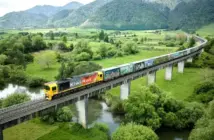The government has been talking about getting freight off the country’s roads and onto alternative sea freight and particularly rail freight, National Road Carriers Association CEO David Aitken notes

Rail freight has its place and the road freight transport industry is already its biggest customer, but it also has its limitations.
If Europe is any example, nothing much will change, despite the government and KiwiRail’s best efforts.
Trucks will always be required to deliver a large portion of the country’s freight demand.
While bulk freight can be transported by rail or sea, market demand in the freight industry will dictate how customers want their goods moved.
Since 2000 the European Union has provided policies and incentives to shift freight off the road to rail, coastal shipping and Europe’s extensive canal system.
They haven’t worked. Road still carries about 75% of all Europe’s freight.
The total tonnage carried by rail and other modes has gone up but so has road freight, so the proportion each carries has remained about the same.
The market has continued to decide which form of freight to use, rather than incentives and tax breaks.
Improvements to rail infrastructure in Europe have only resulted in small increases in rail freight carried, so rail has been reluctant to make large capital expenditure, because the returns aren’t there.
The same is likely to apply to New Zealand.
Road freight will always be preferred for any perishable goods because it can carry out the task faster – apart from much more expensive air freight.
Road freight has greater service quality – quicker door-to-door delivery times and greater safety with less chance of damaged goods, which usually occurs when the freight is changed from one mode to another.
Even when rail or sea is used, trucks are often needed to get goods to the rail hub or sea port to start the journey and then pick them up to make the final delivery.
Highly competitive costs within the road freight sector make it more appealing to customers than the alternatives.
Road freight has flexible route choices. Rail and sea do not with only a few fixed routes.
Road freight will nearly always be used for the “last miles” as customers want door-to-door delivery.
Rail is only generally better when the type of goods (very large or non-urgent) can be shipped by train instead of road.
This occurs when a customer places all their business with a road freight operator who then decides the best way to ship it to meet deadlines or budget.
Improving New Zealand’s rail services and infrastructure will be taxpayer funded and subsidised.
Improvements in road freight transport – newer fleet with cleaner emissions, less noise – are paid for by the trucking companies and their customers.
Rail will only ever handle a small proportion of the country’s total freight as 90% of road freight is done within metropolitan/urban areas where rail and sea are not an option.
With the increased investment in the rail sector and KiwiRail remaining a commercial operating arm of the government, this is likely to require rail price increases to cover the investment costs, closing the gap between road and rail pricing, making the later less attractive to freight customers.




